
Pacific Northwest Steamboats, page 2
Steamer Portland
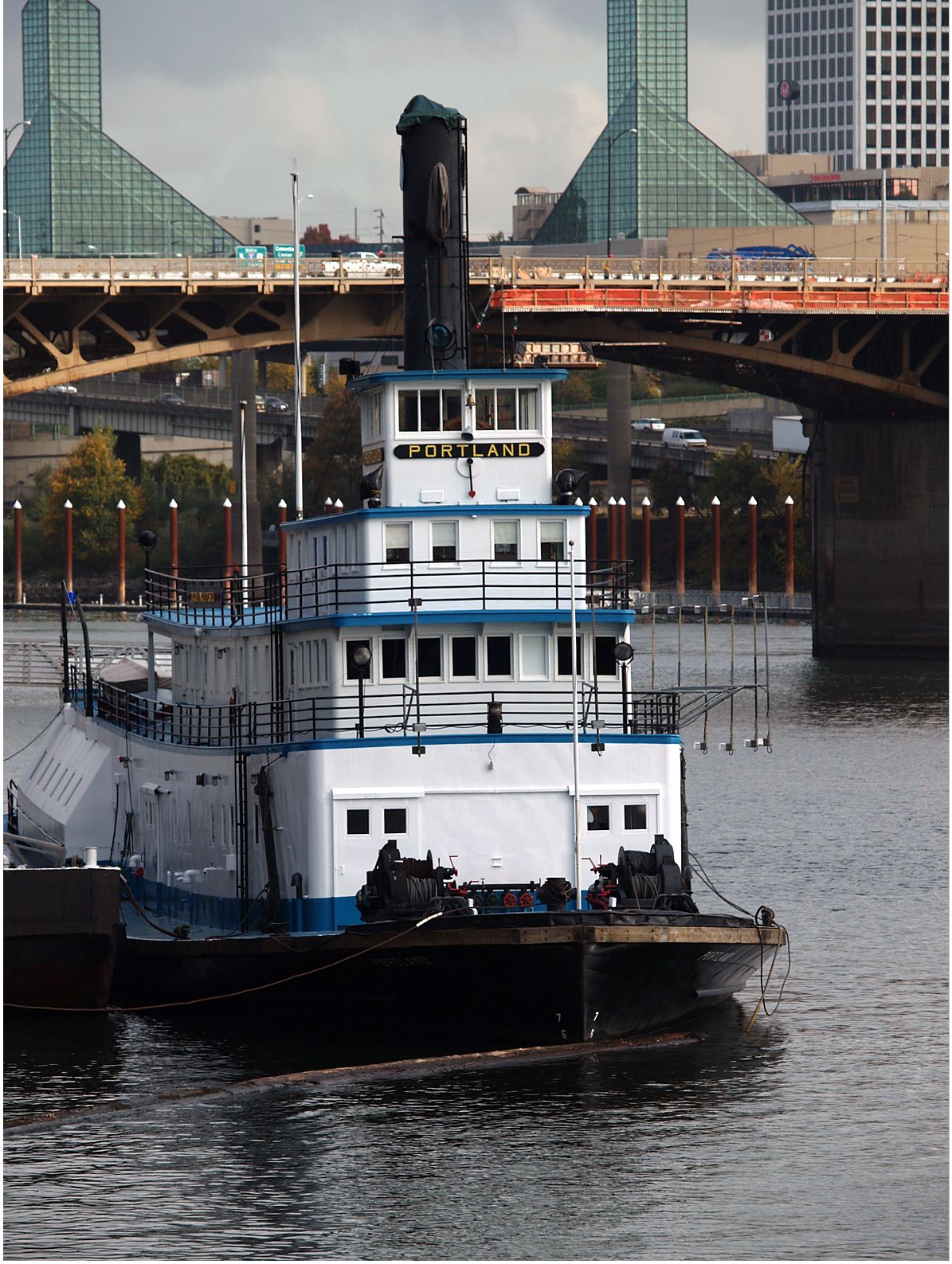
Attached photo I took of the PORTLAND at Portland, Oregon, on the Willamette River in October '06. This was in the morning before she was open for tourists. I stayed in a spiffy old hotel a few blocks away so I could walk down in the morning and luxuriate in seeing the old girl. That lumpy black chef's hat on top of her stock was put there only the week after some drunken local teenager had climbed the ladder on the stack and plummeted down the into the PORTLAND's innards. He was arrested and hospitalized.
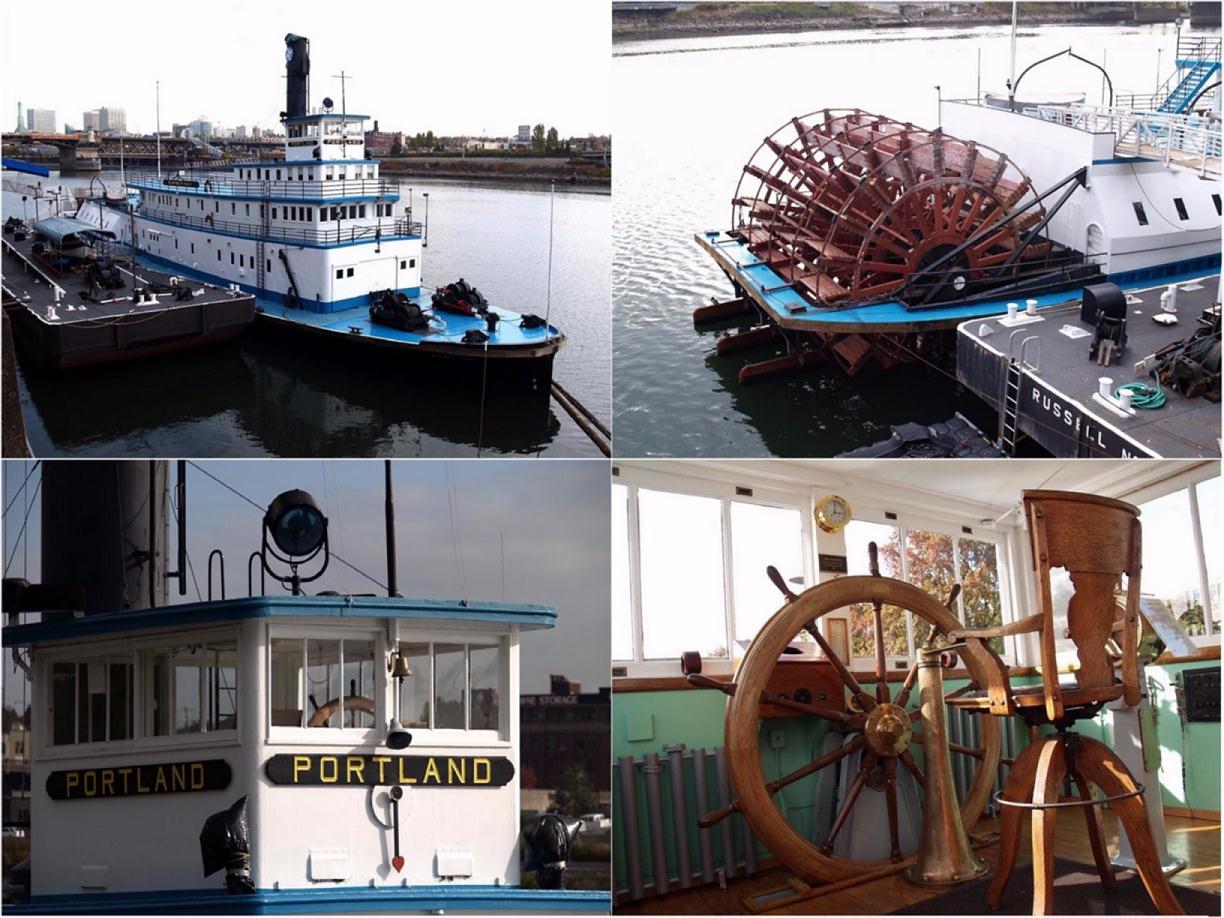
4 of the pix I took in ought-six of the steamboat PORTLAND moored on the Willamette River next to Tom McCall Waterfront Park in downtown Portland, Oregon. The interior of the pilot house is especially tantalizing . . . could live there easily.
While under steam on the Columbia River PORTLAND experienced misadventures in 2008 and on Friday the 13th of July, 2012. Both of those events were documented below on The Old Salt Blog where videos of the 2012 accident can be viewed.
oldsaltblog.com
"Privateer Royaliste, the Sternwheeler Portland and the Very Bad Friday the 13th"
July 18, 2012
by Rick Spilman
Correction: Based on local news reports, we originally posted that water pressure from the steamer Portland's paddle-wheel damaged the Royaliste. We were incorrect. The Portland (as seen in the posted videos) clearly backed into the ketch, which was tied up alongside the dock.
Friday, June 13th, should have been a great day at the first St. Helens Maritime Heritage Festival for both the 55' privateer ketch Royaliste and the 186' historic stern-wheel steamer Portland. Both ships were making debuts of a sort. The Royaliste has been undergoing extensive restoration for several years and her first public re-appearance was last Friday. Likewise, the sternwheeler Portland, built in 1949 and owned by the Oregon Maritime Museum, was carrying its first passengers down the Columbia River since a mechanical failure nearly sent it plummeting over the Bonneville Dam in 2008.
Unfortunately, things did not go well when the vessels crossed paths. The Royaliste was at the dock when the Portland came backing down. The sternwheeler's rail struck the ketch's starboard side, opening several seams in the ketch's planking. (See the video). The Royaliste immediately began taking on water and was saved from sinking by portable pumps provided by U.S. Coast Guard and the Columbia County Sheriff's Office marine unit. According to its Facebook page, the Royaliste has made it back to its home port in Schooner Creek and is being kept afloat by pumps pending the arrival of the insurance surveyors.
The steamer Portland has had a troubled past. The Oregon Maritime Museum bought the Portland for $1 in 1991. The steamer was originally intended to be a stationary exhibit for the museum, but after restoration, the Portland was put into service giving occasional tours of local waters to museum members and guest. This came to an abrupt halt when the Coast Guard learned that the vessel was carrying passengers and yet had never been inspected.
For the next seven years the Portland remained stationary while upgrades were made to meet Coast Guard safety requirements. In 2008 the vessel was put back in service. In June of that year she participated in the first stern-wheeled steam boat race on the Columbia River in 56 years.
The race did not go well. Outside Cascade Locks, the Portland's steering locked up and it plowed into the bank, damaging the paddle wheel. Without power or steering, the boat drifted helplessly towards the Bonneville Dam. Until a tugboat arrived to pull it to safety, there were fears that the stern-wheeler and her passengers would go over the dam.
Thanks to Robert Kennedy, Alaric Bond and Melanie Sherman for passing along the news.
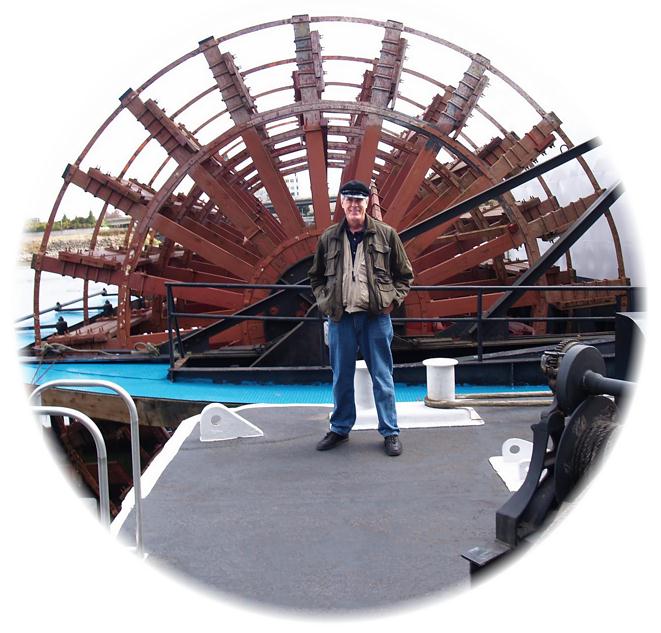
Dave Thomson on the barge in front of the PORTLAND sternwheel.
steamboats.org
The Str. PORTLAND was built at Portland, Oregon, in 1947 by Northwest Marine Iron Works for the Port of Portland as a sternwheel towboat to replace the previous Steamer Portland which was built in 1919.
The hull was steel constructed and it supported wood upper decks; cabin deck, texas deck and wheelhouse.
She was decommissioned in 1981. Operated by two independent river tug boat companies, Western Transportation and Shaver Transportation, she served her entire working life as a Portland Harbor tug.
In 1989 she was adopted by the Oregon Maritime Museum as it's premier exhibit and still serves the Portland waterfront in that capacity. She is fully operational and periodically steams-up.
Length: 186.1'; beam: 42.1'; depth of hold: 9'; draft: 5.5; gross tonnage: 928; net: 733. Engines: 26" dia - 9' stroke; boiler pressure: 250 pounds.
Oregon Maritime Center & Museum
113 S.W. Front Ave.
Portland, OR 97204
Phone (503) 224-7724
Open 11 am - 4 pm, Fridays & Saturdays
Excursion Boat Columbia Gorge

Attached photo I took of a rainbow created by water and sunlight off the sternwheel of the excursion boat Columbia Gorge on the Columbia River last October. The C.G. runs out of her spring/summer/fall base at the town of Cascade Locks, Oregon. On the 4 hour trip I was on, she went downriver (west) and was lowered through the locks at Bonneville Dam, continued west for a spell before turning around and heading back upriver where she got raised back up again at Bonneville en route to home. The scenery of that stretch of river (known of course as the Columbia Gorge) is breathtaking and it was a perfectly beautiful day for it.
During the winter the Columbia Gorge is in Portland. This was one of her last trips before the season ended. She's diesel powered but has the authentic look and feel of the old Columbia River steamboats.
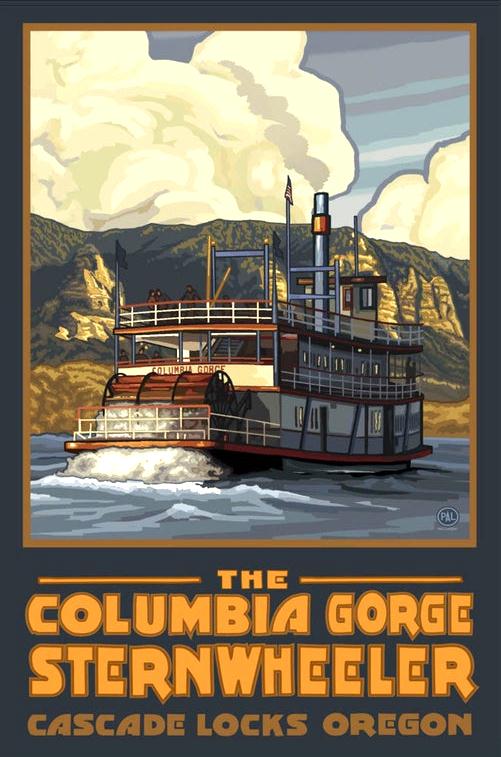
Sternwheeler Columbia Gorge Oregon
Giclee Art Print Poster
from Original Travel Artwork
by Artist Paul A. Lanquist
etsy.com
This work of art was designed by Artist Paul A. Lanquist (PAL), a Pacific Northwest artist who currently lives in central Oregon. Through the years, PAL has gravitated to the work of illustrators from the 20's, 30's, and 40's that use color and design to communicate their ideas in a straightforward way. By combining the nostalgic look and feel of the past with the spectacular scenery of this country, PAL has created destination and travel posters that capture the beauty and life style of these unique areas.
Steamer Keno
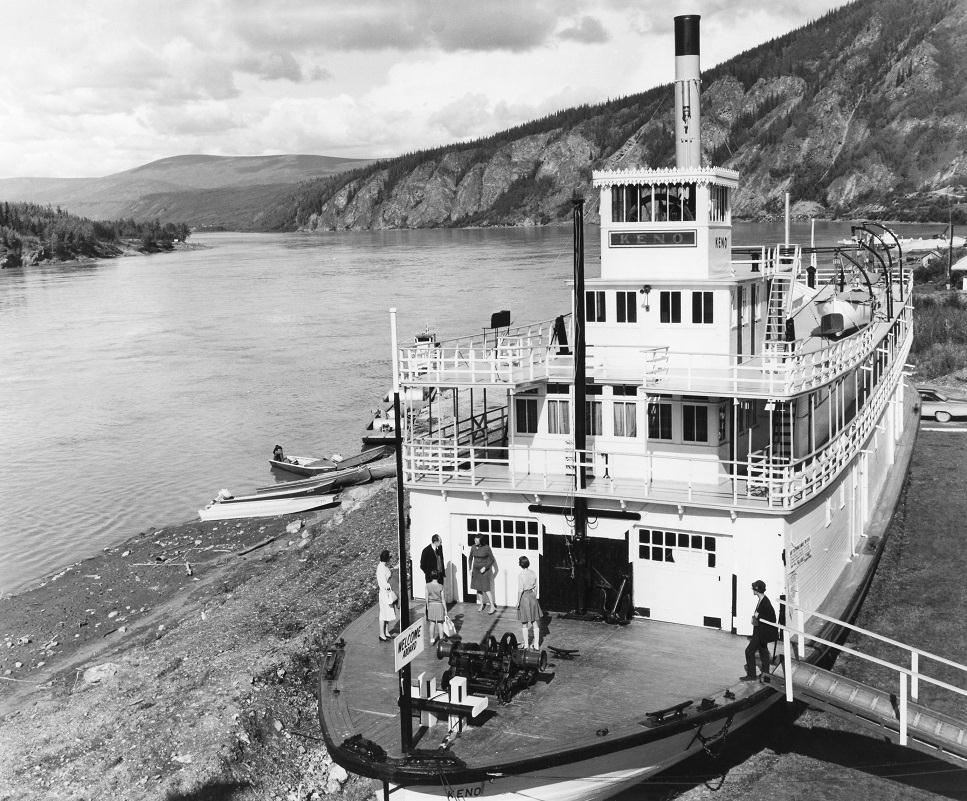
Steamer KENO exhibited at Dawson City, Yukon Territory 1982
PRESS RELEASE PHOTO 1982 - Caption
Dawson City's Museum in Yukon Territory, Canada features the historic sternwheeler KENO, now on dry land next to the Yukon River. Paddlewheel steamboats carried passengers and freight for half a century after the discovery of gold on Alaskan and Canadian rivers.
Most of the original boats are gone except for a few maintained as museums.
Westours photo by Bob & Ira Spring 30 April, 1982
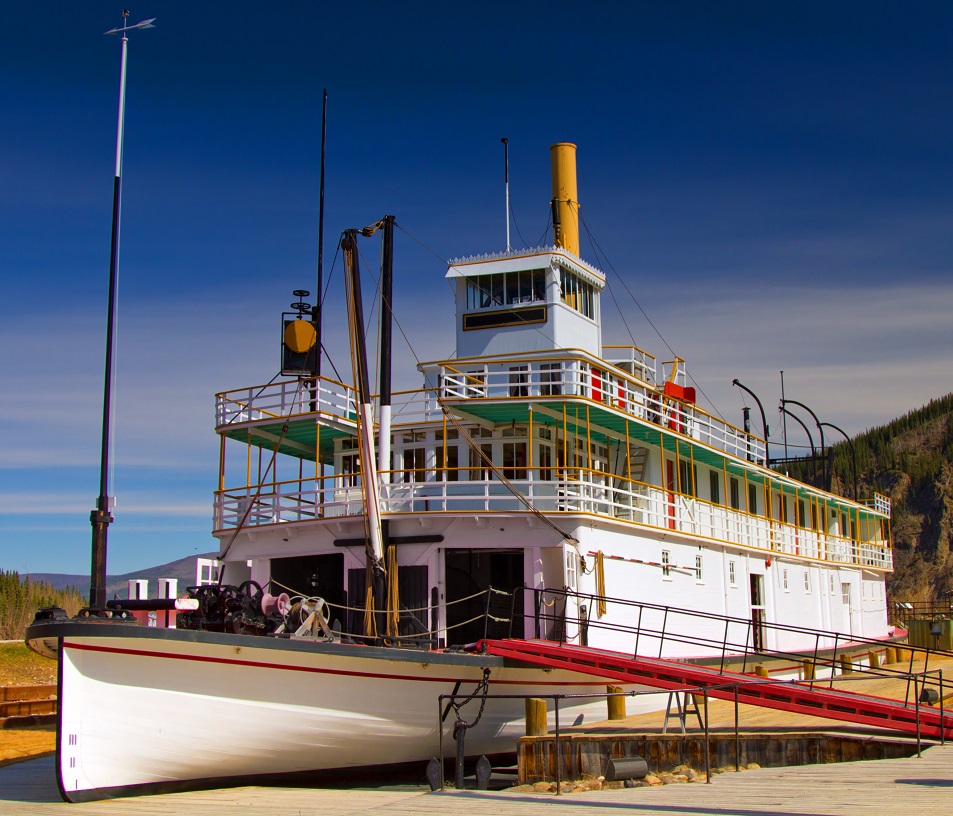
Steamboat KENO at Dawson City, Yukon
Photo by A. Michael Brown
ID 62850579 © Amichaelbrown | Dreamstime.com
Steamer Klondike
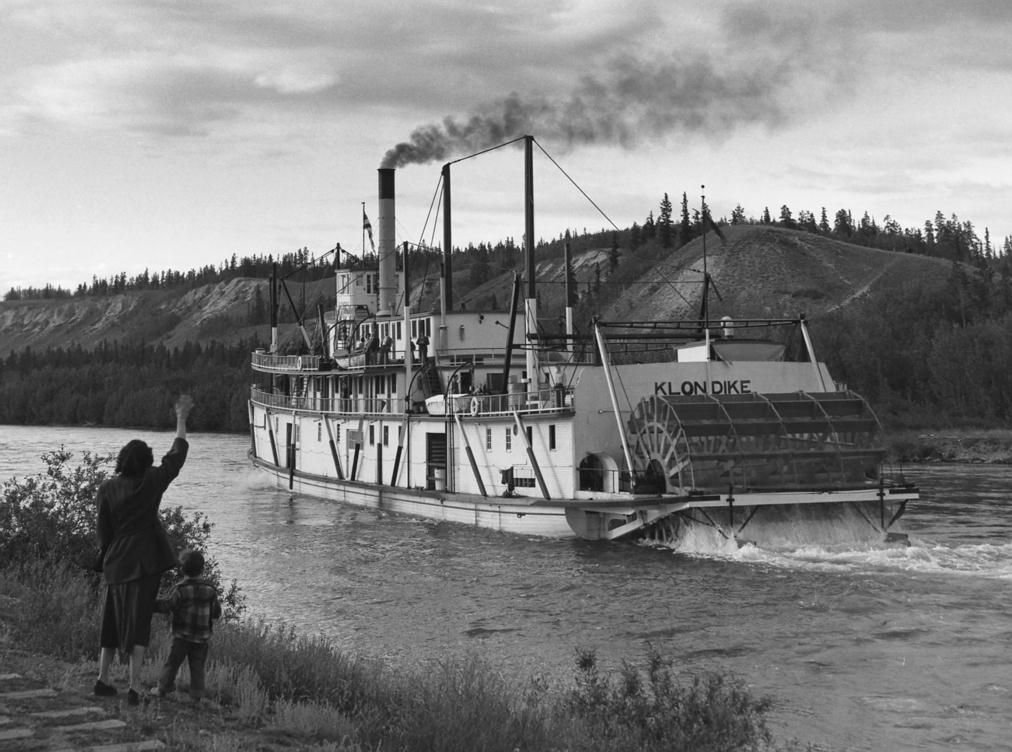
Str KLONDIKE on the Yukon River 1956
Press release 8 x 10 photo dated 23 April 1956 promoting travel to Alaska via Pan American airlines.
Caption on back:
Sternwheeler steamboats, reminiscent of the days of Mark Twain and the Mississippi, still ply regular routes along the Yukon River. The KLONDIKE, shown above, is available to summer visitors to the territory, according to Pan American World Airways. Alaska offers a wonderful opportunity for hunting and game fishing, besides sightseeing and visits to the relics of the gold rush and the Russian occupation.
PAN AMERICAN WORLD AIRWAYS 135 East 42nd Street New York 17, New York
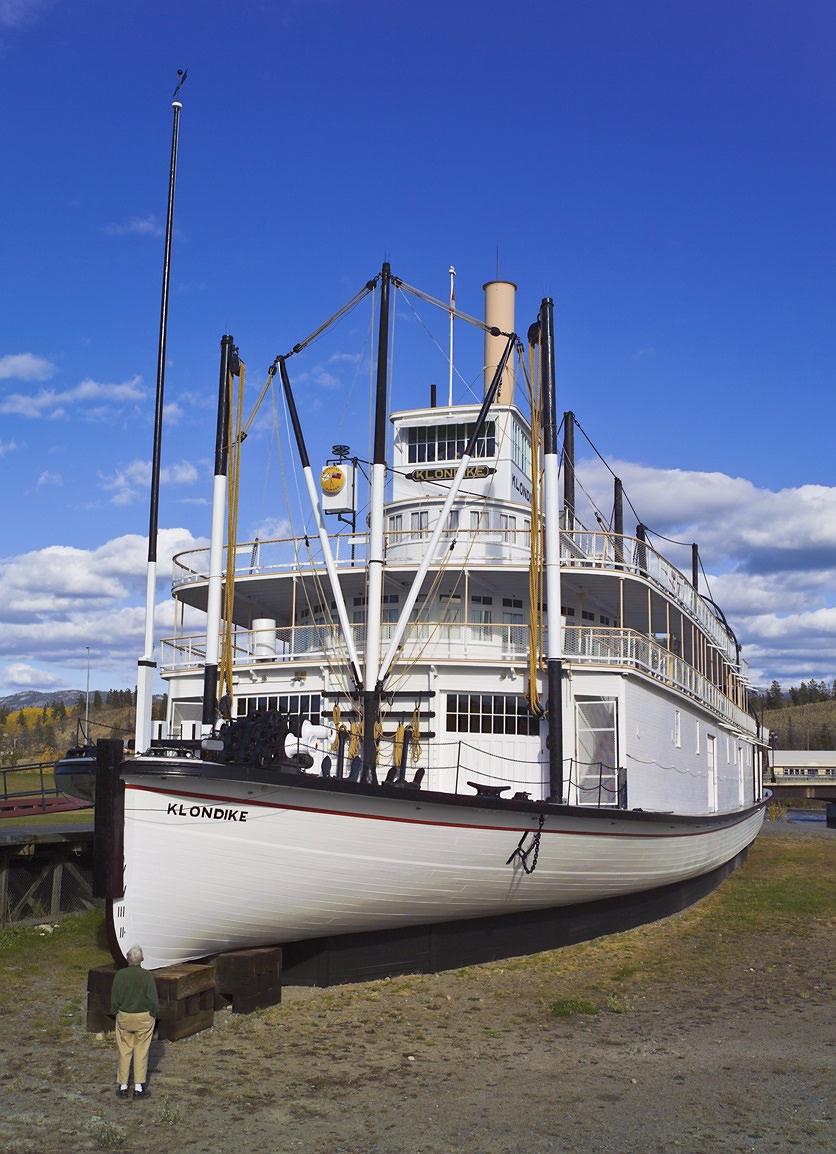
THE "KLONDIKE" BOW VIEW AT WHITEHORSE ON THE YUKON
The KLONDIKE was built in 1929, carried cargo and passengers along the 460-mile route on the Yukon River between Whitehorse and Dawson City until 1955. It now rests on the west bank of the Yukon close to the Robert Campbell bridge in Whitehorse, Yukon, Canada.
ID 20780936 © Reinhardt | Dreamstime.com
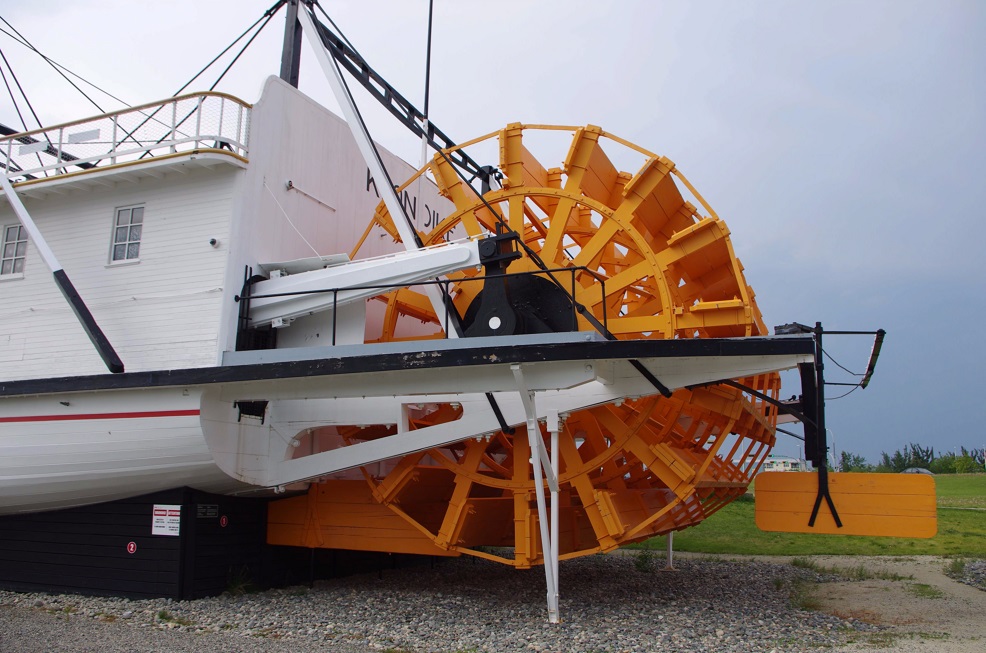
Sternwheel of the KLONDIKE at Whitehorse in the Yukon
ID 146967246 © Pascalou95 | Dreamstime.com
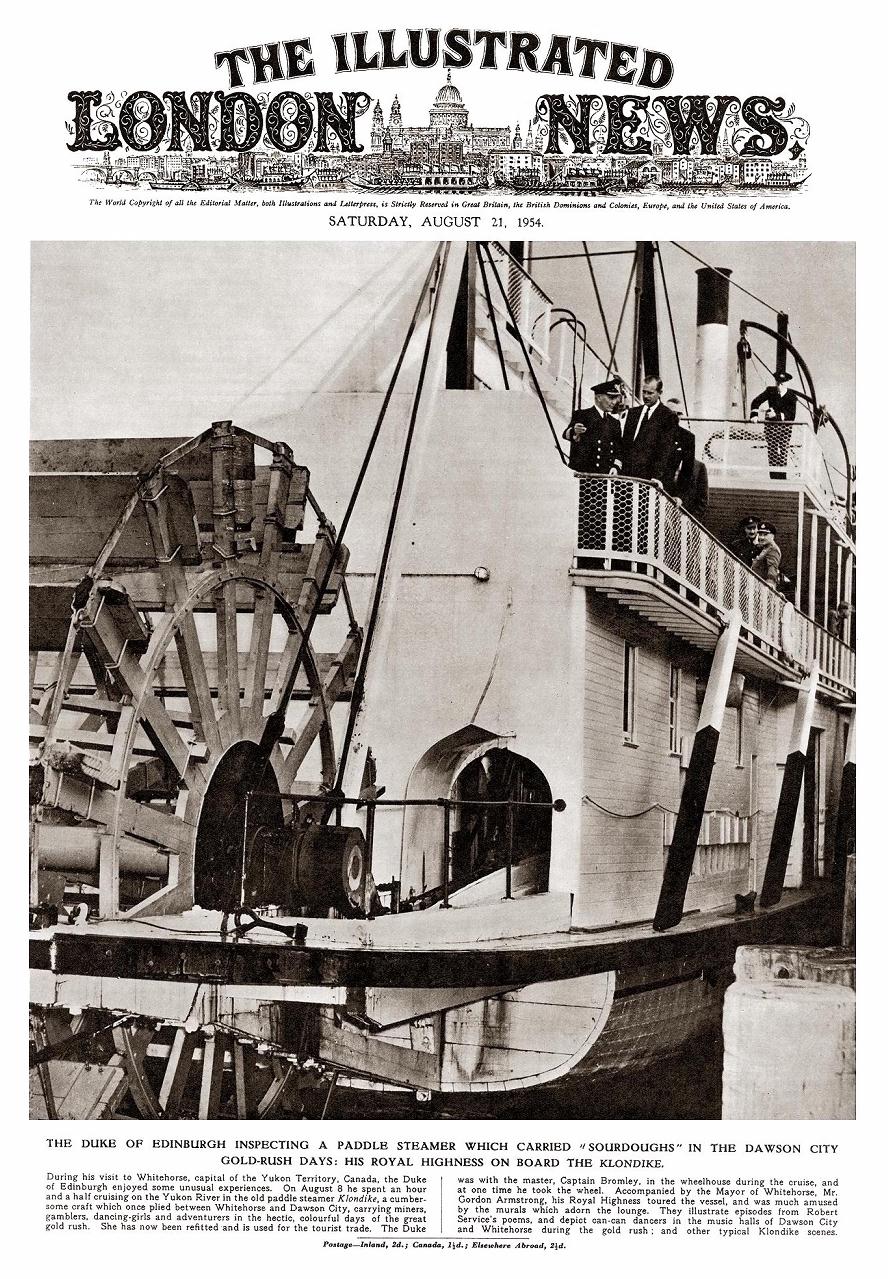
Prince Phillip aboard the sternwheeler S.S. KLONDIKE in August 1954
Here is a saga in Yukon history with Prince Phillip (Queen Elizabeth's husband) who bears the title of Duke of Edinburgh visiting Whitehorse, Yukon Territory CANADA where he was the honored guest aboard the sternwheeler S.S. KLONDIKE, immortalized in the attached cover from the 21st August 1954 edition of the Illustrated London News (see caption in addition to the following article on Yukon history on the Hougen Group website):
The Day the Duke Came to Town
A CKRW Yukon Nugget by Les McLaughlin
hougengroup.com
It was hot that Sunday in August back in 1954. By mid-day, the temperature had risen to 80° F. The quiet town was livelier than usual. The water truck, that would normally be parked in the city garage, was rushing up and down Fourth Avenue, pumping gallons of water on the dusty gravel streets. School teachers were handing out Red Ensign Flags. Alex Seely was pruning pansies in a 45-gallon oil drum. Shop-keepers were busy hanging red, white and blue bunting. The door to Sam McGee's cabin on Elliott Street was wide open. Taylor and Drury's mechanics were putting the final polish on a snazzy Oldsmobile. This was no normal Sunday.
Royalty was coming to Whitehorse. The imminent arrival of the dashing Duke of Edinburgh would mark the first time a member of the Royal Family would visit the Yukon. Only a year earlier, Prince Phillip had wowed the world with his smashing good looks and courteous personality when his wife was crowned Queen Elizabeth II, ruler of the vast British Empire including the far-off Yukon.
The Duke arrived in Whitehorse at noon, August 8th on a four-hour, direct flight from Vancouver, where he had been the Royal representative at the British Empire Games, where he had witnessed fellow Brit Roger Bannister break the fabled four-minute mile. That was a special moment for Prince Phillip, who was now known around the globe as an avid sportsman, a man in love with the great outdoors, a fabulous horseman and strong swimmer. However, a deep gash on his royal nose proved that he could use some lessons in the art of Olympic diving. He had cut himself while plunging into the UBC swimming pool during the Vancouver games. Like everything with the Royals, that nose gash was big news.
Now this world figure was coming to tiny Whitehorse, where the streets were unpaved, wooden sidewalks creaked in winter and heaved in summer, and there were no traffic lights. There was no city sewer system, although a plebiscite in June had just approved the hotly debated topic of whether Whitehorse should rid itself of back-yard cesspools and open wells in favour of a modern system of running water carried in - of all things - underground pipes. What would they think of next!
The plebiscite was fiercely contested, since many taxpayers thought they could not afford such luxury. One of the ads in the paper that convinced the rate-payers to fork over the dough was a banner full-page, edged-in-black message claiming that the Queen, on a visit to Australia earlier in the year, had to wear rubber gloves to avoid contamination of her regal personage by foul water. The Yukon ad asked if Prince Phillip would have to wear rubber gloves to avoid contamination and the possibility of contracting polio from tainted water in the Yukon's capital. "If we don't get it - we've had it" blazed the headline. The plebiscite carried.
At noon on that idyllic August Sunday, Commissioner Wilfred Brown, Mayor Gordon Armstrong, and a bands from the RCAF base met the Duke's royal plane. They ushered him into a polished yellow Oldsmobile and drove down the winding, old Two Mile Hill to the newly constructed Whitehorse Elementary High-school on Fourth Avenue, for a meeting with the children of the Yukon, including Lena Tizya, to whom he was introduced as she had represented the Yukon Girl Guides at the Queen's Coronation in 1953.
The Fleet Street Press from London, a photographer from the world's most popular news magazine "LIFE" (on the cover of which appeared a photo of the Duke in front of WHS), and a contingent of Canadian cameramen and writers recorded the Duke's every move, so much so that an editorial in the Whitehorse Star a week later praised the visit, the Duke, the kids and Yukoners in general, but slammed the "outside" press, calling them rude, crude and impudent in pushing aside anyone who got in the way of their "photo-op."
Later that memorable Sunday, Prince Phillip embarked on a once-in-a-lifetime trip down the Yukon River a few miles, on board the newly renovated paddle-wheeler SS KLONDIKE, that had just been put back into service by the White Pass and Yukon Route, who in co-operation with Canadian Pacific Airlines began an ill-fated and wildly expensive gamble to bring tourist dollars to the awakening, but still largely unknown Yukon tourist industry.
On board the Klondike, Phillip observed a large painting depicting Cancan girls dancing up a storm, and asked Mayor Armstrong: "Do you have any around here like this?" Diplomatically, the gracious mayor offered instead an ivory desk pen set that he had bought earlier in the day from the Yukon Gift and Ivory Shop.
That evening the RCAF mess was the location of a gala - or what in Yukon terms in the fifties could pass as a gala evening of food and conversation. The Duke talked at length with 88-year-old Martha Louise Black and her 81-year-old husband George, both of whom had spent some time in England when they were Members of the Canadian Parliament. George had been speaker of the House of Commons in the thirties, and when he fell ill prior to the 1940 general election, Martha ran for his Yukon seat and became only the second woman to sit in the House of Commons.
The Duke was fascinated by Martha's tale of her life as one of the few women who climbed the Chilkoot Pass on her way to the Klondike in 1898. With some irony, Prince Phillip also listened intently as aboriginal elder Patsy Henderson told him the story of his days as a young boy, back in 1898, in a camp with his uncle Skookum Jim, on the banks of the Klondike River when Jim, Tagish Charlie and George Carmack found the gold that made the Yukon famous, and drew Martha and her husband George to the Yukon.
Urban legend has it that a server during the evening meal advised Prince Phillip not to give up his fork so quickly after the main course, because "there's still pie coming, Duke."
Bright and early, Monday morning, August 9th, 1954, the royal visitor boarded his Canadian government plane and headed north to Coppermine, in the Northwest Territories, for a quick tour of the Arctic. Of the visit, Life Magazine noted "the Duke not only enjoyed himself hugely but brought back a winter's worth of dazzling tales of the wild north world to tell the queen, as well as a pair of Eskimo soapstone carvings for Princess Anne and Prince Charles."
Steam Ship Moyie
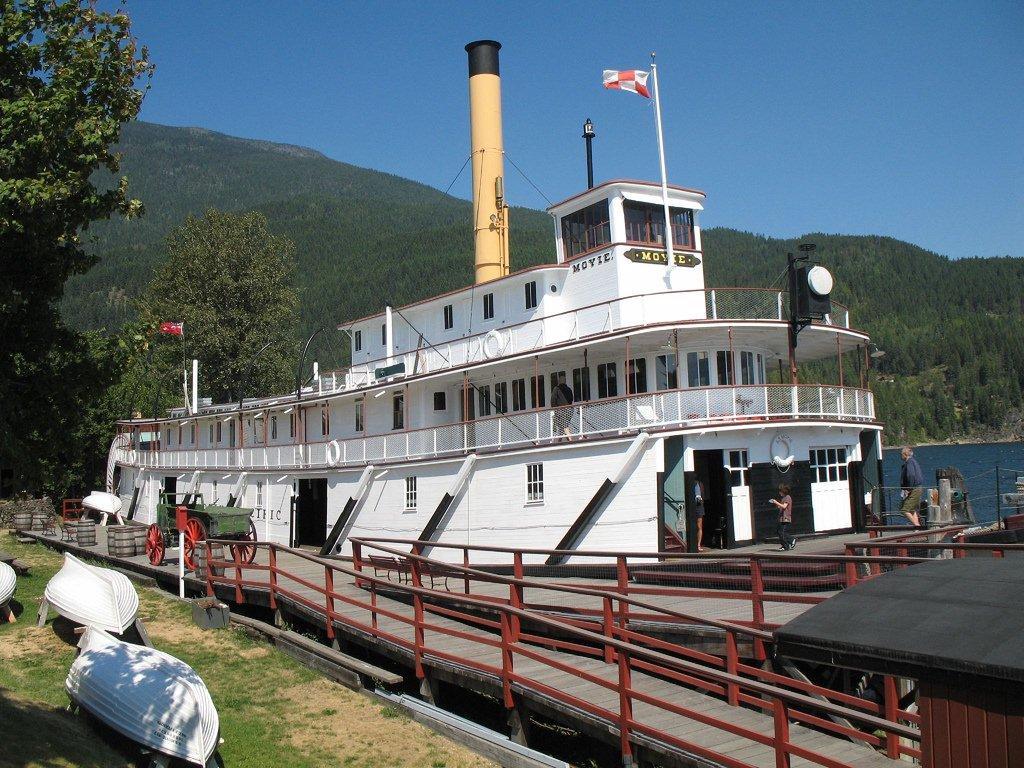
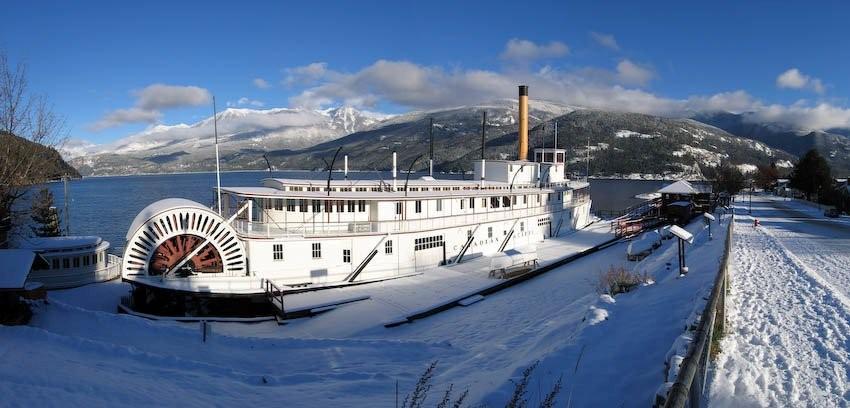
It's a "fur piece" to fly up and then to see the MOYIE but Jim says it's well worth the effort. Believe this photo was off "flickr." Nice pristine in white, good as new . . . You may already have the MOYIE's link on your site. klhs.bc.ca The S.S. Moyie sternwheeler is one of the most significant preserved steam passenger vessels in North America. When the Moyie was retired in 1957, after a 59-year career with the Canadian Pacific Railway's BC Lake and River Service, she was the last operating passenger sternwheeler in Canada. She is in a surprisingly complete state for a vessel with such a long service record. The SS Moyie is located in the beautiful town of Kaslo, in the West Kootenay region of British Columbia.
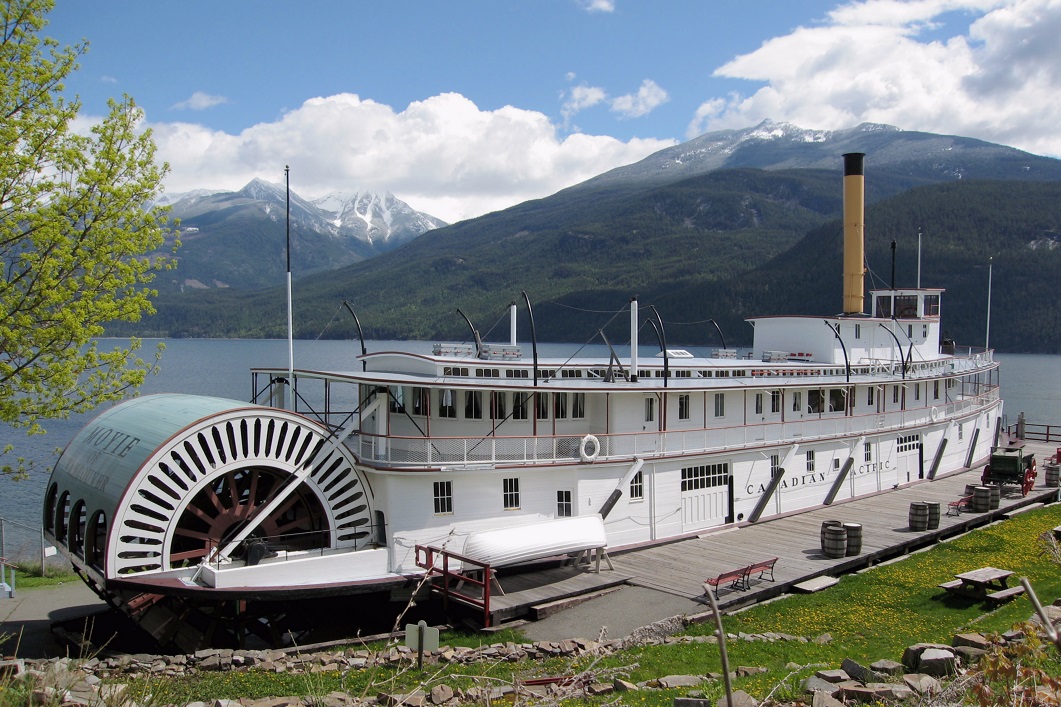
Steamboat MOYIE at Kaslo, British Columbia
Photo by Jaahnlieb ID 86135678 © Jaahnlieb | Dreamstime.com
Queen of Seattle
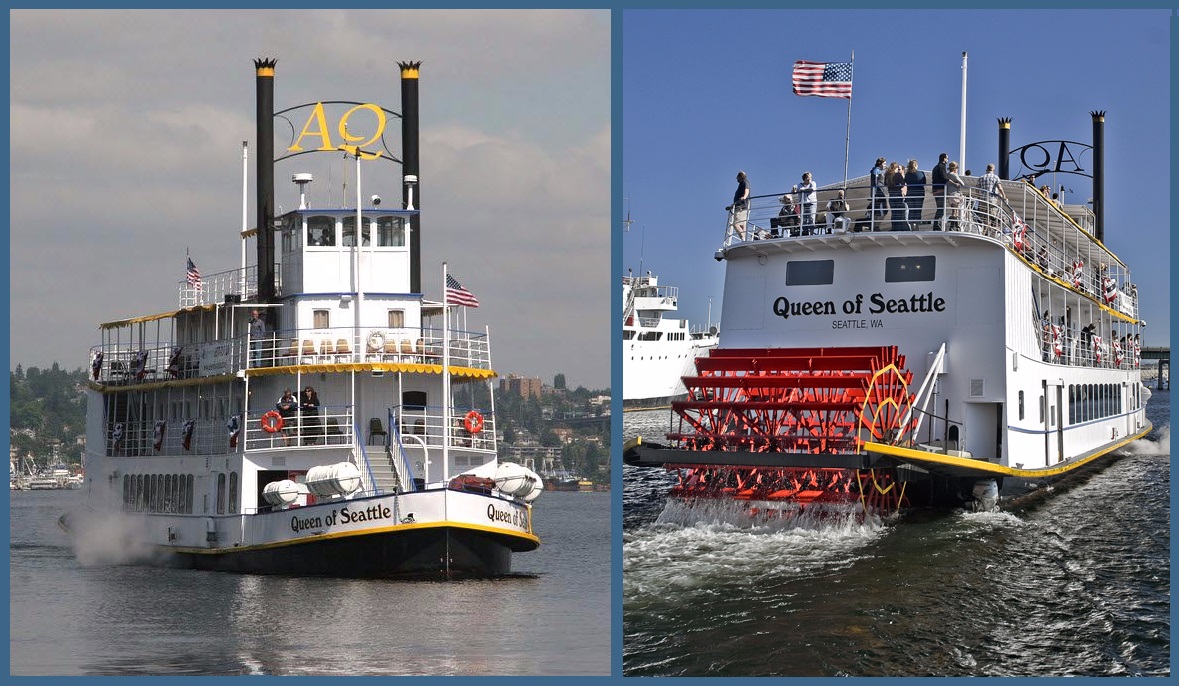
The QUEEN of SEATTLE at Seattle, Washingon. The initials "AQ" between her stacks originated during her second incarnation as the ALASKA QUEEN in Alaska.
seattletimes.com
At quarter of its value, Queen of Seattle paddle-wheeler still for sale
Originally published July 2015The price has recently been cut to $250,000 on the 138-foot Queen of Seattle, a steam-powered, paddle-wheel boat moored on Lake Union.By Jack Broom Seattle Times staff reporterShe has worked in three states under three different names. She loves to party, and has her own bar, cabaret stage, dance floor, player piano and 38-whistle calliope. There's even a touch of mystery in her background, stemming from the fact that her first owner's body was found in a California river in 2003—a death never fully explained. Call her Queen of Seattle. That's the name this 138-foot paddle-wheeler used on her most recent job, taking visitors on a 2-1/2-hour loop around Lake Union from 2010 to 2013. "I love her. She's an amazing piece of history," said Lisa Dindinger of Alaska Travel Adventures, owners of the boat since 2005. "She needs loving care and someone with the know-how to make the best of her."
The steel-hulled vessel, which can carry up to 400 passengers, has the classic "floating wedding cake" look of a paddle-wheel riverboat, with its bright-red, 24-foot-diameter stern wheel. Dindinger said her company decided reluctantly that the boat isn't a good fit with its Alaska focus, and has offered it for sale for more than two years. Based on an insurance appraisal that put the boat's replacement value at more than $1 million, Dindinger said, the company first listed it for sale at $895,000, then dropped the price after about a year to $500,000 and—in the last two weeks—to $250,000.
Any potential purchaser would need pockets deep enough to cover not just the purchase price, but the succession of expenses for moorage, maintenance, fuel, insurance and renovations that will follow.
And there's this: Anytime the boat is under way, the Coast Guard requires that it have a licensed steam engineer on board.
Dindinger admits only a small slice of the boat-buying public would have a use for a vessel like this. She's had a couple of recent inquiries, but nothing that panned out.
The boat was built in Sacramento in 1984 as the "Elizabeth Louise" by Harold Wilmunder, whom Dindinger said was a sign maker by occupation and a steam engineer by hobby. He didn't operate a consistent tour business with the boat but did some charters and special events, and took friends and family for rides along the Sacramento River.
One day in 2003, the 78-year-old Wilmunder got a call from police saying it appeared a hatch had been forced open near the boat's bow. Wilmunder went to investigate and was never seen alive again.
After his body was found in the water between a Coast Guard boat and a dock, authorities said the death appeared to be a drowning but were hesitant to rule out possible foul play. Dindinger said she and her husband learned of the boat online and found Wilmunder's widow willing to sell. The boat was barged to Seattle, renovated and then steamed its way Ketchikan to begin running tours under the name "Alaska Queen."
(It still carries the initials "AQ" in gold letters high between its smokestacks, even though the hull identifies it as the Queen of Seattle.)
But Dindinger said the Coast Guard was concerned that the boat, which is tall, narrow and sits high in the water, might not be stable enough for winds and waves in Southeast Alaska, which could be as strong as those in the open ocean.
So the tour company brought the boat down to Seattle and put it to work on Lake Union. But Dindinger said it's been difficult for the company to give the boat tours proper attention, since its other operations are based in Alaska.
Dindinger said she doesn't expect the price to drop below the $250,000, adding that it could cost nearly that amount to dispose of the boat. "We sure hope it doesn't come to that," she said.
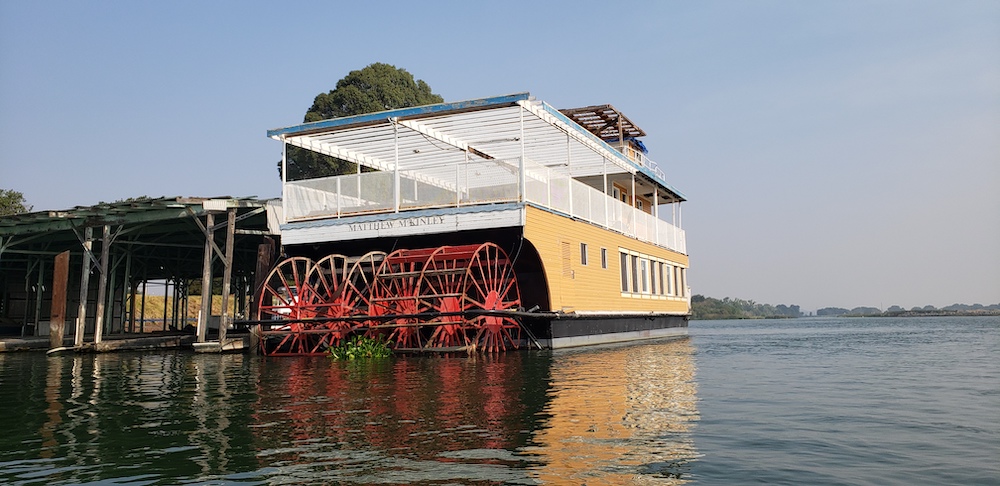
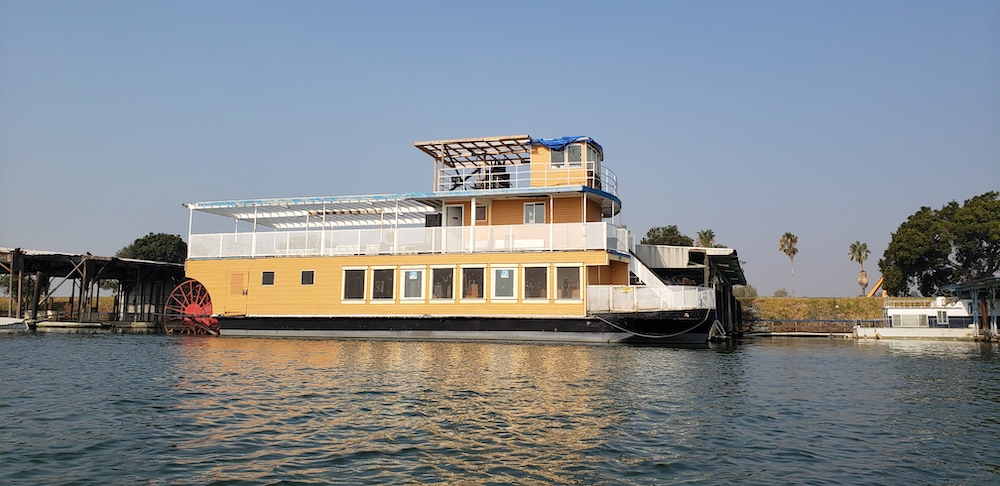
Summer of 2020, Gerd Stieler spotted and photographed the McKinley at a marina on the Threemile Slough, where the Sacramento and San Joaquin Rivers merge, sixty miles east of San Francisco Bay. IThe McKinley used to dock in Old Town Sacramento, along side the Delta King, but disappeared without a trace several years ago. Photos by Gerd Stieler.

With the exception of images credited to public institutions,
everything on this page is from a private collection.
Please contact Steamboats.com for permission for commercial use.*
All captions provided by Dave Thomson, Steamboats.com primary contributor and historian.
